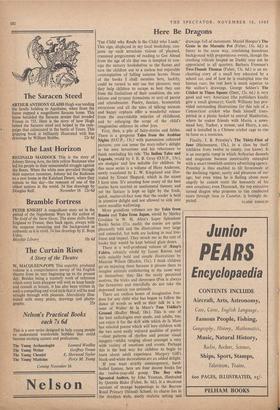Dragons Here Be
`THE Child who Reads is the Child who Leads.' This sign, displayed in my local bookshop, con- jures up such atrocious visions of planned, crammed programmes of reading to Get Ahead from the age of six that one is tempted to con- sign the nursery bookshelves to the flames and turn the children out to a useless but enjoyable contemplation of falling autumn leaves. None of the books I shall mention here, luckily, could be turned to any use but pleasure; may they help children to escape as best they can from the limitations of their condition, the am- bitions and tyranny (conscious or not) of parent and schoolmaster. Poetry, fantasy, broomstick excursions and all the tales of talking animals and happy orphans offer a wonderful release from the unavoidable miseries of childhood, and by enlarging the scope of the child's imagination enhance its other joys.
First, then, a pile of fairy-stories and fables. There is a gorgeous Tales from the Arabian Nights (O.U.P., 15s.) with pantomime coloured pictures; you can sense the story-teller's delight in his own inventions and his reluctance to finish unwinding his tale. The Indian Tales and Legends, retold by J. E. B. Gray (O.U.P., 15s.), are stodgier and less suitable for children. In this same series is a volume of Hans Andersen, newly translated by L. W. Kingsland and illus- trated by Ernest Shepard, which is, the nicest I have seen. It's amazing how many of the best stories have morbid or sentimental themes; and yet the fantasy is kept so light by the fresh, quick, matter-of-fact tone that the reader is held in attentive delight and not allowed to sink into mere maudlin wallowing.
More grandiose volumes are the Tales from Russia and Tales from Japan, retold by Shirley Goulden in W. H. Allen's Super Splendour Books Series (21s. each); the stories are quite pleasantly told and the illustrations very large and colourful, but both are lacking in real live- liness and impact. They struck me as the sort of books that would be kept behind glass doors.
There is a well-produced volume of iEsop's Fables, robustly retold by James Reeves and with suitably bold and simple illustrations by Maurice Wilson (Blackie, 15s.). I think children go on enjoying these because it pleases them to imagine animals misbehaving in the same way as themselves; they like the easily perceived motives, the tricks and cleverness (Fox is always the favourite) and mercifully do not take the depressed morals too seriously. There are endless hours of imaginative free- dom for any child who has begun to follow the dance of words as well as their talk in a re- issue of Walter de la Mare's Tom Tiddler's Ground (Bodley Head, 18s.). This is one of the best anthologies ever made, and adults, too, can enjoy it for the skill with which de la Mare has selected poems which will lure children with the two most easily enjoyed qualities of poetry —clear patterns of rhythm and precise visual imagery—whilst ranging about amongst a very wide variety of emotions and events. Perhaps this is the best way for children to begin to learn about adult experience. Margery Gill's black-and-white decorations are an added delight.
If you want strictly contemporary, hard- boiled fantasy, here are four decent books for the twelve-year-old group. The Boy who Sprouted Antlers, by John Yeoman, illustrated by Quentin Blake (Faber, 8s. 6d.), is a decorous account of strange happenings in the Burrow Road Primary (Mixed) School; its charm lies in the deadpan style, nicely realistic setting and drawings full of movement. Muriel Hooper's The Genie in the Marmite Pot (Faber, 13s. 6d.) is funny in the same way, combining humdrum background with preposterous events, though the crushing ridicule heaped on Daddy may not be appreciated in all quarters. Barbara Freeman's Two-Thumb Thomas (Faber, 13s. 6d.) is an en- chanting story of a small boy educated by a school cat, and of how he is readopted into the human race; the text here is much superior to the author's drawings. George Selden's The Cricket in Times Square (Dent, 12s. 6d.) is very good and very American (the publishers kindly give a small glossary); Garth Williams has pro- vided outstanding illustrations for this tale of a Connecticut cricket who finds himself trans- ported in a picnic basket to central Manhattan, where he makes friends with Mario, a news- stand boy, Tucker, a mouse, and Harry, a ,cat, and is installed in a Chinese cricket cage to rise to fame as a musician.
Finally, J. B. Priestley's The Thirty-First of June (Heinemann, 15s.), in a class by itself (children from twelve to ninety, you know). It is an energetic romp in which Arthurian damsels and magicians become inextricably entangled with a smart twentieth-century advertising agency. Priestley is thus enabled to tilt ferociously at the declining vigour, sanity and pleasures of our age; but even when he is flailing about most angrily he cannot resist the humanity of his own creations; even Dimmock, the top executive turned dragon who proposes to run conducted tours through time to Camelot, is lovingly de- picted. CLAIRE TOMALIN










































 Previous page
Previous page